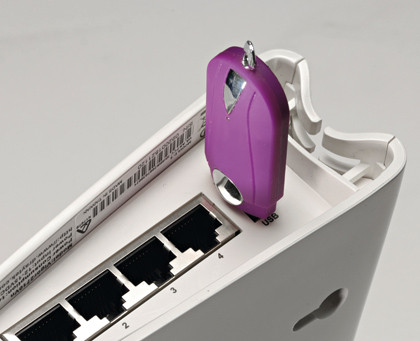An increasing number of routers now include USB ports along with the usual LAN and WAN ports. Typically, these will be used as an easy way of adding network storage: plug in a USB drive and it'll be freely available to everyone on the network. Well, sort of.
One complication is how the router presents the drive to the rest of your network. What you ideally want is support for Windows Server Message Block (SMB), which provides a standard way for apps to locate, read and write files to a network resource. As long as this is included then you should be able to browse the network in Explorer, 'see' the router's USB drive, map this to a network drive on your PC and use it as normal.
Some routers offer rather less convenient methods. For example, the Asus RT-N13U forces you to access the drive through a built-in FTP or HTTP server, which probably won't be ideal for most people.
Don't assume that seeing 'FTP' in the spec means this will always be the case, though. The Linksys WRT610N, for instance, supports external hard drives as well as USB keys, and these can be used as FTP servers, media servers, SMB-based external drivers, or all three at the same time. Handy!
Not to be outdone, other manufacturers have added even more USB functionality. Some DrayTek routers, such as the Vigor 2710, provide a USB port that allows printers to be connected and shared across the network.
And D-Link's SharePort technology lets you plug just about any USB device into a router such as the DIR-685, then access it on any PC on your network as though it was connected locally. This requires extra software to be installed on your network PCs, and only one can use the device at a time, but it could still be useful.
Before you opt for a solution such as this, it's worth thinking about how it might affect overall performance. If it's a large network, and the router is already likely to be fully occupied most of the time, then do you really want it handling additional file transfers and print jobs?
Get daily insight, inspiration and deals in your inbox
Sign up for breaking news, reviews, opinion, top tech deals, and more.

We've also noticed that USB devices connected to a router are noticeably slower than when plugged into a PC – that's no real surprise when you think of all the work the router's processor is doing. So, while USB storage is useful for basic things (as long as you make sure it supports SMB), if you have heavy-duty requirements then a dedicated network storage device will still offer the best speeds.
Once you've decided on the basic hardware you need, it's time to consider the software-based features – and none are as important as security.
So it's fortunate that just about every 802.11n router comes with a good set of security features: firewall, intrusion detection, the latest WPA2 encryption, and WPA and WEP if you need them for older devices. Avoid the latter two if you can: WEP is easily cracked and of no real value, and using WPA may drastically cut performance.
While every router comes with some form of firewall, the implementation varies greatly. Some are very simple, but DrayTek routers in particular are as configurable as their software-based cousins.
The DrayTek Vigor 2910G, for instance, has built-in support for around 30 instant-messaging apps, eight P2P protocols and 16 web-streaming applications.It's easy to add more, and you're able to create custom filter sets to control what traffic is allowed and what will be blocked.
The most interesting security features are often the more unusual extras. One of our favourites is the ability to set up a guest zone (also known as 'guest access'). This allows the router to create a separate wireless network that provides access to your internet connection, but keeps users isolated from more valuable resources, such as your PCs. That's perfect if, say, you don't mind your kids' friends using the network to get their iPods online, but you'd rather they didn't poke around any further.
If you need to connect to the company network from home, Virtual Private Network (VPN) support will probably be useful. At a minimum, your router should offer VPN passthrough for IPSec, PPTP and L2TP: this means it'll recognise VPN traffic and allow it to pass through your firewall and other protective layers.
Some routers only support passthrough for a single session – a hassle if you need more than one connection. Ideally, you'll want support for multiple concurrent sessions, and this doesn't have to be expensive: D-Link's DIR-655, for instance, includes it for around £65.
If that's not sufficient, look for a router with VPN endpoint capability, which means it's able to initiate a VPN connection itself. A few routers, such as the Buffalo Nfiniti Wireless-N, come with a complete integrated VPN server. If the router supports remote access, and that's a feature you'll use, consider how it's protected.
Some D-Link routers now use a CAPTCHA-style 'type the letters you see in the box' graphic, making it much more difficult for hackers to use brute-force attacks on your system. Others may let you limit access to particular IP addresses, or customise the port number used.
A feature to investigate carefully is any talk of 'content filtering' or 'parental controls'. Sometimes these turn out to require a subscription. Occasionally they're competent free packages, such as NetGear's Live Parental Controls, but in many cases, they're near-useless keyword-based efforts where you manually enter a few suspect words and the router blocks any webpage that uses them.
If you need decent parental controls then download the router manual before you buy it, and take the time to find out what's included.
Current page: Wireless N routers: USB access and security
Prev Page Wireless N routers: what's the hardware to buy? Next Page Wireless N routers: super speed